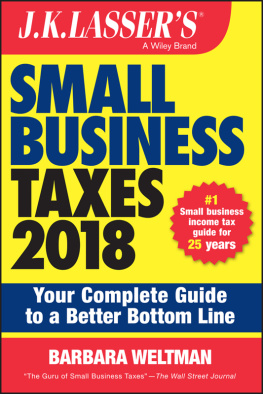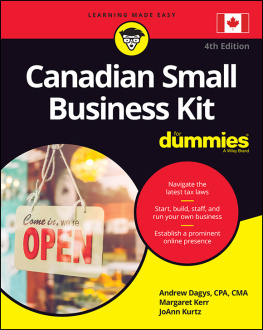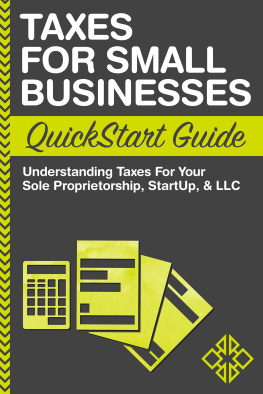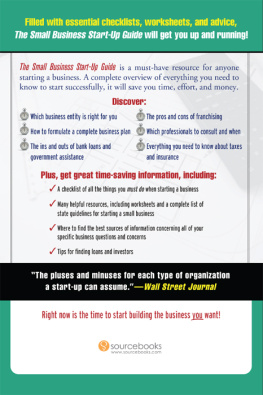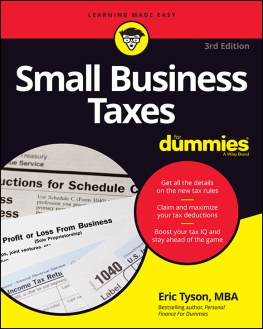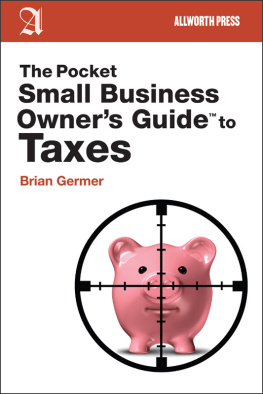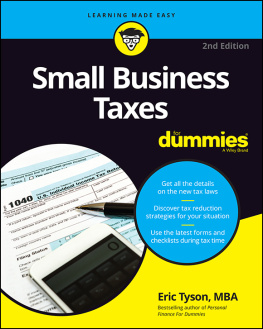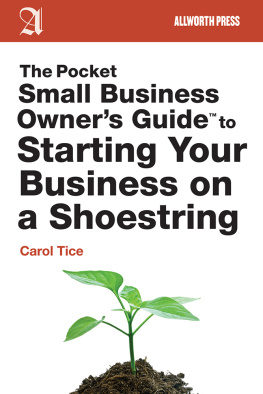
Cover design: Wiley
Copyright 2018 by Barbara Weltman. All rights reserved.
Published by John Wiley & Sons, Inc., Hoboken, New Jersey.
Published simultaneously in Canada.
No part of this publication may be reproduced, stored in a retrieval system, or transmitted in any form or by any means, electronic, mechanical, photocopying, recording, scanning, or otherwise, except as permitted under Section 107 or 108 of the 1976 United States Copyright Act, without either the prior written permission of the Publisher, or authorization through payment of the appropriate per-copy fee to the Copyright Clearance Center, Inc., 222 Rosewood Drive, Danvers, MA 01923, (978) 750-8400, fax (978) 646-8600, or on the web at www.copyright.com. Requests to the Publisher for permission should be addressed to the Permissions Department, John Wiley & Sons, Inc., 111 River Street, Hoboken, NJ 07030, (201) 748-6011, fax (201) 748-6008, or online at http://www.wiley.com/go/permissions.
Limit of Liability/Disclaimer of Warranty: While the publisher and author have used their best efforts in preparing this book, they make no representations or warranties with respect to the accuracy or completeness of the contents of this book and specifically disclaim any implied warranties of merchantability or fitness for a particular purpose. No warranty may be created or extended by sales representatives or written sales materials. The advice and strategies contained herein may not be suitable for your situation. You should consult with a professional where appropriate. Neither the publisher nor author shall be liable for any loss of profit or any other commercial damages, including but not limited to special, incidental, consequential, or other damages.
For general information on our other products and services or for technical support, please contact our Customer Care Department within the United States at (800) 762-2974, outside the United States at (317) 572-3993 or fax (317) 572-4002.
Wiley also publishes its books in a variety of electronic formats. Some content that appears in print may not be available in electronic books. For more information about Wiley products, visit our web site at www.wiley.com.
ISBN 978-1-119-38041-2 (paper)
ISBN 978-1-119-38040-5 (ePDF)
ISBN 978-1-119-38046-7 (ePub)
This book is dedicated with love to my
understanding husband, Malcolm Katt.
Preface
According to a 2017 report from the National Federation of Independent Business (NFIB), 84% of small businesses use paid tax preparers to file their returns. So why do you need to read up on taxes? The answer is simple: You, not your accountant or other financial adviser and not software, run the business, so you can't rely on someone else to make decisions critical to your activities. The National Small Business Association (NSBA) found that 67% of small businesses say that federal taxes have a significant or moderate impact on the day-to-day operation of their businesses. You need to be informed about tax-saving opportunities that continually arise so you can strategically plan to take advantage of them. Being knowledgeable about tax matters also saves you money; the more you know, the better able you are to ask your accountant key tax and financial questions that can advance your business, as well as to meet your tax responsibilities.
This is a great time to be a small business. Not only is small business a major force in our economy but it also is the benefactor of numerous tax rules that make it easier to write off expenses and minimize the taxes you owe. This edition of the book has been revised to include all of the new rules taking effect for 2017 returns. Your business needs to use every tax-saving opportunity to survive and thrive at this time. The book also provides information about future changes scheduled to take effect in order to give you an overall view of business tax planning. Most importantly, it addresses the many tax questions I have received from readers as well as visitors to my website, www.barbaraweltman.com.
This book focuses primarily on federal income taxes. Businesses may be required to pay and report many other taxes, including state income taxes, employment taxes, sales and use taxes, and excise taxes. Some information about these taxes is included in this book to alert you to your possible obligations so that you can then obtain further assistance if necessary. However, the book takes a holistic approach to taxes, showing you where applicable the ramifications that tax decisions can have on your business activities and your bottom line. Statistics, resources, and other materials are provided to help you better run your business by making good tax decisions and implementing sound business practices.
Whether or not you use a paid tax professional to prepare your tax return, expect to devote considerable time to taxes as part of running your business. The NFIB found that 42% of small businesses spend 4 hours or more each month on tax compliance, and 12% spend 10 hours or more each month. Also be prepared to spend money not only on your tax payments but also on administrative costs (e.g., accountants' fees). Nearly half of small businesses spend more than $5,000 annually, and 27% spend more than $10,000 each year, according to the same report. In another report, the Small Business Association found that 66% of owners polled thought taxesthe administrative hassles and costthreatened their viability. And the NFIB found that 5 of the top 10 most severe problems facing small businesses are tax-related.
It is important to stay alert to future tax changes. Uncertainty has been labeled an impediment to business growth. Pending or possible changes from Congress are noted in this book, including the expiration of nearly a dozen tax rules at the end of 2016 that can impact your 2017 tax return and tax planning for 2018. Be sure to check on any final action before you take any steps that could be affected by these changes.
For a free supplement on tax developments after September 1, 2017, affecting small businesses (available in February 2018), go to www.jklasser.com or www.barbaraweltman.com.
How to Use This Book
The purpose of this book is to make you acutely aware of how your actions in business can affect your bottom line from a tax perspective. The way you organize your business, the accounting method you select, and the types of payments you make all have an impact on when you report income and the extent to which you can take deductions. This book is not designed to make you a tax expert. It is strongly suggested that you consult with a tax adviser before making certain important decisions that will affect your ability to minimize your taxes (and Chapter 32 tells you how to work with a tax professional). I hope that the insight you gain from this book will allow you to ask your adviser key questions to benefit your business.
In Part 1, you will find topics of interest to all businesses. First, there is an overview of the various forms of business organization and an explanation of how these forms of organization affect reporting of income and claiming tax deductions. The most common forms of business organization include independent contractors, sole proprietors, and sole practitionersindividuals who work for themselves and do not have any partners. If self-employed individuals join with others to form a business, they become partners in a partnership. Sometimes businesses incorporate. A business can be incorporated with only one owner or with many owners. A corporation can be a regular corporation (C corporation), or it can be a small business corporation (
Next page
